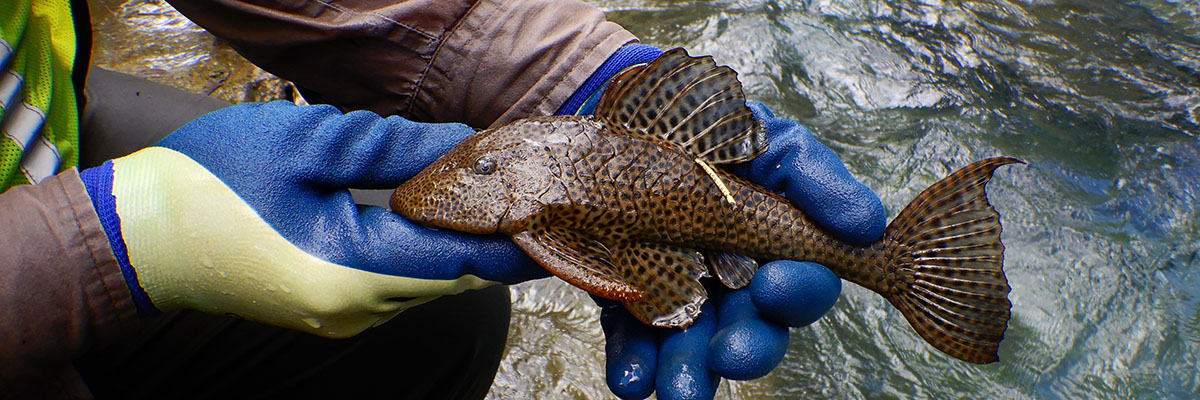Research
Aquatic ecosystems include some of the most imperiled species in the United States and invasive species are the second leading contributor to this problem. Research plays a critical role in guiding effective, science-based monitoring and management of aquatic invasive species. Below is a short description of ongoing and past research projects funded by Texas Parks and Wildlife Department. For more information on the invasive species studied in these projects and other aquatic invasive species in Texas, visit texasinvasives.org.
Research Grants
The application period is closed for the FY26-27 AIS Research Grants. Please check back here or on the TPWD grants page in early2027 (early January anticipated) for the next request for proposals for FY28-29.
New Aquatic Invasive Species Research
Evaluation of the effectiveness of herbicide mixtures for Wintertime and Summertime treatments of Giant Salvinia
Texas A&M AgriLife Extension Service
This project seeks to experimentally evaluate the comparative effectiveness of many different aquatic-approved herbicide mixtures for use to control highly invasive giant salvinia in winter and summer seasons. The ultimate goal of this research is to identify herbicide mixtures that will be most effective, which could potentially reduce labor, cost, and amount or frequency of herbicide application needed. Managing giant salvinia as effectively as possible strongly supports efforts to minimize the impacts of this aquatic invasive plant on outdoor recreation, and aquatic life and habitats.
Controlling invasive armored catfish: growth, reproduction, and spearfishing efficacy
Texas State University
This project seeks to augment current knowledge on invasive suckermouth armored catfish growth and reproduction in the highly invaded San Marcos River as well as expand on previous suppression models that evaluate the efficacy of spearfishing methods currently used for population control. This project will optimize models while also considering effects of different management strategies. The ultimate goal of this project is to provide recommendations for further improved management practices as well as enhance knowledge that will contribute to enhancing monitoring and success. While this study will directly support ongoing efforts to control these species in the San Marcos River to reduce their harmful impacts on aquatic life and infrastructure, the recommendations are anticipated to benefit control efforts elsewhere in the state as well.
Using snorkel surveys and removal experiments to identify ecological overlaps and competitive exclusion between three native darters and invasive suckermouth armored catfish
The University of Texas at San Antonio
This study will seek to assess habitat use and overlap between invasive suckermouth armored catfish and three darter Species of Greatest Conservation need to determine whether the invasive fish affect abundance and habitat use of the native species that could have negative effects. The study will also compare efficacy and body size bias of three different armored catfish removal methods as well as various aspects of timing. Ultimately, the project seeks to develop a decision-support tool that will enhance ongoing control efforts by providing guidance for population suppression and habitat management with a focus on locations where harmful impacts may be greatest.
Ongoing Aquatic Invasive Species Research
Developing spawning protocols and identifying the sex determining regions in suckermouth armored catfish to facilitate the production of neofemales and YY males for use in population control
Texas A&M University
This project seeks to develop genomic resources for invasive suckermouth armored catfish to facilitate production of YY males for use in genetic/biological population control. This project will also begin to test protocols for spawning these species and beginning the process of feminizing males. This work will contribute to furthering efforts to control these invasive species.
Assessing seasonal variation in thermal refugia use and drivers of angler participation in removal efforts of suckermouth armored catfish in San Felipe Creek, Val Verde County
University of Texas at San Antonio
This study will evaluate use of thermal refuges (e.g., springs) by suckermouth armored catfish during winter months to increase survival. Locating aggregations of this invasive species can aid in enhancing removal efforts. This study will also examine angler interest in participating in removal tournaments, including any seasonal differences in willingness to participate. This work will aid in enhancing ongoing removal efforts.
Distribution of the Australian redclaw crayfish in Texas
University of Texas at Tyler
Invasive Australian redclaw crayfish have become established in South Texas, but little is known of their distribution. This study will evaluate distribution of this species in Texas as well as abundance and life-history traits. This work is an important step toward better understanding this invasion as well as facilitating potential future assessments of impacts on native species.
